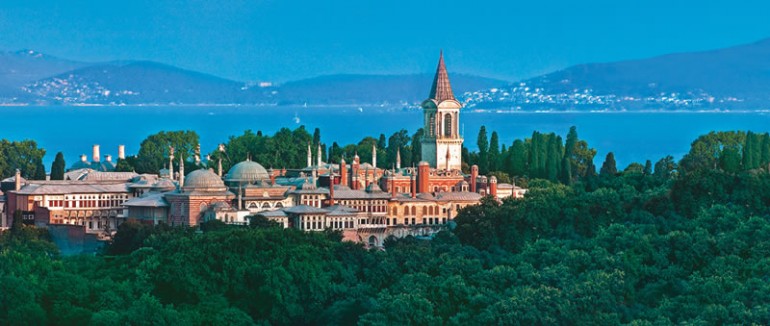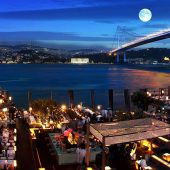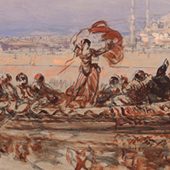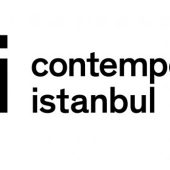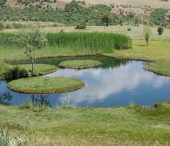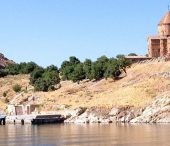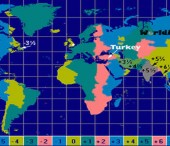Topkapi Palace, which was used as the administrative and domicile center of the Ottoman Empire for almost 400 years, is the oldest and largest palace that has survived up until today.
It was built by the conqueror of Istanbul, Mehmed II, between the years 1458-1478, and it was up until the 19th century that other extensions were made by other sultans who ruled after him.
During the reign of Sultan Abdulmecid, the Palace lost its primary importance as it was seen to be inadequate for the needs of the State protocols of the 19th century and therefore had moved to Dolmabahce Palace built on the Bosphorus in 1854. However, the Sultanate’s treasures, the Holy Relics and the archives of the Empire were protected and certain traditional ceremonies and celebrations continued to take place at Topkapi Palace. Following the abolishment of the Ottoman Sultanate in 1922, Topkapi Palace was converted into a museum on the order of Mustafa Kemal Ataturk on the 3rd of April 1924. The Museum, which also offers audio guidance services, is open to the public every day of the week except on Tuesdays.
HISTORY
Following the conquest, Fatih Sultan Mehmed Han had built a palace in Bayezit, which would later be called the Old Palace, where Istanbul University stands today. After this initial palace, Fatih then built the Tiled Pavilion and later Topkapi Palace.
Fatih called this palace Saray-i Cedid, which means “the New Palace”. The palace received its current name when Sultan Mahmud I had a large wooden palace constructed near the city’s Byzantine walls, in front of which were placed several ceremonial cannons; this seaside palace was named the Cannon Gate Palace by the Sea (Topkapusu Sâhil Sarâyi), and, when this palace was destroyed in a fire, its name was transferred to Mehmed II’s New Palace.
It was actually during the period of Sultan Abdulmecid that Topkapi Palace was opened as a museum for the first time. The commodities within the Treasury of the Topkapi Palace were exhibited to the English Ambassador of the time. Following this, it became tradition to exhibit the old commodities of the Treasury of Topkapi Palace to the foreigners and during the era of Sultan Abdulaziz, glass showcases in Empire design were made and all the antiques of the Treasury were exhibited to the foreigners. During the final years of Abdulhamid the Second, it was decided that the Imperial Treasures of Topkapi Palace would be exhibited for the public but this decision was never actualised.
On the 3rd of April 1924 with the order of Mustafa Kemal Ataturk, Topkapi Palace, which was assigned to the Istanbul Asar-i Atika Museums Administration, became open to the public. It was then that it initially began its services with the names Treasury Trust (Hazine Kethudaligi) and later The Treasury Administration. Today, it continues its services under the name of the Administration of Topkapi Palace Museum.
Topkapi Palace, which developed and grew over the centuries, had a design that played an important role in Ottoman governmental philosophy and in the relations between the Palace and its subjects. When Topkapi was first built, its plan was influenced by the splendor of the Edirne Palace located on the Tunca River, which had been constructed by Fatih’s father, Sultan Murad II, but very little of which remains today. The basic design of the Palace is centered on various courtyards and gardens, around which are arranged offices devoted to State affairs, the buildings and pavilions serving as the residence of the sovereign, and the buildings set aside for the court employees who lived in the palace.
Entrance is located through the main gates called “Bab-i Humayun”, which is located on the side facing Hagia Sophia. The following inscription, which was written by Ali b. Yahya es-Sufi, above the gate can be found: “With the sustenance and will of Allah, this holy fortress has been developed and built for the purposes of ensuring safety, by the order of the grandson of Sultan Mehmed Han, the son of Sultan Murad, the sultan of the lands and the ruler of the seas, the shadow of Allah over the people and the jinns, the helper of Allah in the East and the West, the hero of water and soil, the conqueror of Constantinople and the father of conquests, Sultan Mehmed Han – May Allah make his sovereignty eternal and raise him higher than the North star – in the Holy Month of Ramadan of the year 833.” It is comprehended from this inscription that it was built during the month of November of the year 1478.
There is a panelled inscription described as dual with the 45th and 48th verses of Chapter Hijr above the Imperial Gate. From the perspectives of the art of calligraphy and the concept of sovereignty, this inscription has crucial importance. On the other side of the gate, above the signature of Sultan Abdulaziz, there is a part that is adopted from the 13th verse of Chapter Saff which states, “And you will obtain another favour that you love – victory from Allah and an imminent conquest; and give good tidings to the believers.”
It is observed that from the old wood engravings, a pavilion had existed above this gate, which had undergone reconstructions numerous times. This pavilion, which had existed until the end of the 19th century, where parades would be observed from and where the Muhallefat treasures had been kept, was burned to the ground in 1865.
THE DIVISIONS OF TOPKAPI PALACE
THE FIRST COURTYARD/ THE PARADE COURT
Upon entering through the Imperial Gate, one enters the First Courtyard. This courtyard, which has been the location for various parades and ceremonies, was the only section of the Palace that was open to the public and it can still be entered for free today. In the midst of the courtyard close to the Middle Gate, the Deavi Kiosk, which only has the remains of its foundations today, was the place where the public would go to deliver their concerns to the Palace.
On the left side of the courtyard, the Wood Storehouse (Odun Ambari Ocagi) and the Caners Hearth (Hasircilar Ocagi) had existed. The remains of the administration, gaol building and the Patriarchal Palace, which were built at the end of the 19th century, as well as the existent Hagia Irene Church and the Imperial Mint, is located on the left side of the courtyard.
Hagia Irene, which was built as the Church of the Patriarchate Palace, is the oldest structure within this courtyard. It was built during the era of Constantine I (324-337) at the beginning of the 4th century. Hagia Irene, which exists in the same courtyard as Hagia Sophia, was burnt down together with Sempson Zenon, when the Nika Revolt took place in 532. Emporer Justinian I rebuilt Hagia Sophia as well as Hagia Irene. Although its reconstruction began in 532, its date of completion is unknown. The violent earthquakes, which took place during the 8th and 9th centuries, caused serious damage to the building. Hagia Irene, which the Byzantinians described as the chapel of the Patriarchate, remained within the Sultanate’s Walls, which circled the Topkapi Palace following the conquest of Istanbul, and as it was not converted into a mosque, there weren’t any significant architectural changes made. It was initially used as the interior artillery and later as the Ministry of War’s Imperial Armoury.
When the Hagia Irene Church was the arsenal of the Palace, it was changed into an archaeology museum during Fethi Ahmed Pasha’s era, and after it moved to its current building in 1894, it was converted into a military museum. Currently, it is open to group visits upon permissions. Also, various concert events are organised at this location too.
The palace workshops, which are located next to the Church, reflect a tradition with roots dating back to the Roman Empire that has continued up until the Ottomans. As well as various craftsmanships like carpentry, bookbinding, gilding and leather works for the Palace, gifts that were sent to foreign States were also prepared in these workshops. The workshop called ‘Hunerveran’ within the courtyard, was transformed into an Imperial Mint for coining money once the Palace was abandoned during the 19th century.
On the right side of the first courtyard, there existed the Treasury, the Enderun Hospital, the bakehouses for the Palace’s bread and Turkish bagels, the Has Firin Mosque, the areas where the wardens resided and a water gauge which contained the fountain from Mahmud the II’s era.
One of the most interesting corners of the First Courtyard was the Fountain of the Executioner (Cellat Cesmesi) or “the Politics Fountain” as it is also called. This structure can be found just before you enter through the Gate of Salutation (Babus Salam). The woodsheds of the Palace were also located in this area.
The first structures, the Tiled Kiosk and Archeology Museums were also located within this First Courtyard.
THE SECOND COURTYARD/ THE DIVAN SQUARE
The two-towered entrance gate called ‘Babus-Selam’ (The Gate of Salutation), which is the passage to the actual Palace and also called the Middle Entrance, has become a symbol of glory of Topkapi Palace and the Ottoman Empire. The Gate of Salutation, which had been built during Fatih Sultan Mehmet’s era, had undergone many renovations during the 16th and 17th centuries. This was the entrance in which only the Sultan could enter through on horseback, while the grand viziers and other state officials would step down from their horses. The women of the Palace would pass through it in their sultanate carriages.
The two towers above the gate were built during the era of Kanuni Sultan Soloman. Within these towers, there also existed The GateKeeper Chambers, which was used to welcome foreign ambassadors, who came to the palace, until permission for their entrance were granted. Today, museum visits begin from this entrance.
The Divan Square, which was built in the 1460s as the second courtyard of the Palace, was the ceremonial ground where the State Affairs took place. The celebration events, ambassador receptions and the ceremony of paying the janissaries every three months took place behind the porch on the right side of this courtyard, where the wooden passage called Culus and the Palace Kitchens are located.
One of the most valuable collections of Topkapi Palace Museum are the Chinese porcelains, which are exhibited together with the Japanese porcelains in Matbah-i Amire, in other words, the kitchen. This collection, which contains more than 10,000 pieces of unique and valuable items, has great importance because it is the largest porcelain collection outside of China and because it illustrates the incessant development of the history and import of porcelains between the 13th century until the beginning of the 20th century.
The Copper and Bronze Artifacts are exhibited within the Helvahane section of the kitchen. All of the cooking utensils within the Palace Kitchen are made of copper. The reason why the copper cooking utensils exhibited in Helvehane are so large is because they were used to cook for all of the residents of the Palace. It is known that, on an ordinary day, food was cooked for at least five thousand people, and this number increased during special events.
One of the most important utensils amongst the kitchen tools were the bronze utensils. The bronze tombacs, which were attained by applying gold and amalgam and had a colour close to gold, took its place in the Ottoman culture during the 16th century but it wasn’t until the 17th century that its use became widespread. There are many tombac pieces belonging to the 18th and 19th centuries in the Palace collections. Amongst these pieces, there are basin-pitcher sets, rose water flasks which are the utensils holding rose oils, censers which were used as incensories, soup bowls, coffee pitchers, ladles and dinner pails. There are also kitchen containers made of stone, marble mortars, small bowls made from coloured stones, service trays, sugar bowls and sherbet chalices in the collection too.
In the Istanbul Glass and Porcelain section of the ‘Serbethane’ (the area where sweet drinks were made) and ‘Helvehane’ (the area where desserts were made), there are almost 2000 pieces of artifacts. The production of glass in Istanbul had begun with Mevlevi Mehmet Dede, who was sent to Italy by Selim the III to learn the techniques of glass-making, and after conducting some research in Venice he returned back to Istanbul. Mevlevi Mehmet Dede, who at the beginning had made products similiar to the Venice glass styles, had in a short period of time been able to produce pieces of the Istanbul glass artworks. In the workshops established in Beykoz, three different techniques were used and with this technique Cesmi Bulbul (the eye of the nightingale), opaline, crystal and white glass were made. Since the 19th century, when Istanbul glass is spoken of it is the Beykoz glassware that comes to mind. The technique, which has become identified with the Beykoz glassware, was Cesm-i Bulbul. Cesmi Bulbul, which means “the Eye of the Nightingale”, is the name given to a type of glassware which is attained by compounding coloured glass sticks and twisting them.
On the other hand, the Ottoman porcelains, which are a part of this collection but were only used in the Palace because they were very expensive, are divided into two separate groups: The Istanbul Art branded porcelains and the Yildiz Porcelains. The Istanbul Art porcelains, which were the first porcelains the Ottomans had produced, were made in the workshops in Beykoz, which was built during the time of Sultan Abdulmecid. Underneath the porcelains, where they were produced in these workshops, exists the stamp of “Istanbul Arts” in Arabic, which have been written with a glazing technique. Generally, the colours used to decorate the art and the colour of the stamp underneath the porcelain were the same colour. The stamped porcelains with the large flower designs were only produced for thirty years, as production had been stopped for financial reasons.
The production of the Yildiz Porcelains, which are the second group of Ottoman porcelains, had begun during the era of Abdulhamid II, in a workshop established in the garden of Yildiz Palace in 1890. The name of the factory was called the Imperial Yildiz Tile Factory. Although the Yildiz Porcelains were initially produced to meet the needs of the Ottoman Palace, it is also a known fact that these were also given as gifts to foreign State Officials and other State Officials of high status. The Yildiz Porcelains were also sent as diplomatic gifts to the Emperor, Kings, Queens, Tsars and Tsarinas of European countries. Although limited in number, it is still possible to see Yildiz Porcelains in the European Palaces.
The European Porcelain and Glassware Collection in the Palace is not currently on exhibition. The European glassware mostly includes basin-pitcher sets, dessert pots, capped bowls, small and large plates, jugs and cups, sherbet chalices, sherbet pitchers, coffee cups and cases, chandelier lanterns and candlesticks. The Bohemian glassware and crystals have a special place in the collection. Since the first half of the 17th century, glassware was produced with a new technique in the glass industry in Bohemia. In this collection, Ludwig Moser, who had worked in the Bohemian Glass Factory between 1857-1893, had specifically made a water set, capped jugs and six glasses for Abdulhamid the Second. There are also French, English and Russian glassware in the Palace’s collection.
The Kubbealti, which is the only tower of the Palace located on the left side of the Divan Court where the Imperial Council meetings were held, is the Justice Tower which symbolises the location where justice is represented. The Divan meetings were held by the leadership of the grand viziers and the presence of high officials. The Sultans would not attend these meetings, but could sit in from a curtained window and high area leading to the Harem from the wall.
The Outer Treasury building is located next to the Kubbealti Chamber where the artillery collection is exhibited. The armoury, which was used by the Ottoman Army, was produced in various manufacturing plants and were held in the artillery warehouses called ‘Cebehane’, where the continuous maintenance and restorations were undertaken. The first Cebehane of the Ottomans was established in Edirne. Following the conquest of Istanbul, the Hagia Irene Church located in the First Courtyard of the Palace, had been turned into a cebehane by Fatih Sultan Mehmed and was used with this purpose until the end of the 19th century. With the initiation of the Tophane Marshall Fethi Ahmet Pasha in the year 1846, the Hagia Irene Church had become the first museum of Istanbul and Turkey called the Old Artillery and Old Artifacts Museum. All of the artillery were kept here until the beginning of the 20th century when Topkapi Palace had been used as a museum. The artillery exhibited here formed the foundations of the Military Museum collection, which is one of the most substantial artillery collections in the world today.
The artillery collection of the Topkapi Palace Museum, which consists of 52,000 pieces of arms belonging to the Arab, Emevi, Mamluk, Iran, Turkish, Crimean-Tatar, Indian, European and Japanese cultures, is one of the forthcoming collections in the world, with its pieces representing a period of 1300 years. One of the most striking sections of this collection, which includes the arms transfered from the Cebehane and the arms used by the Palace Guards, are the exclusive arms which had been produced on special order of the Sultans themselves or which had been produced exclusively for the Sultans as gifts. The arms belonging to Fatih Sultan Mehmed, Bayezid II, Yavuz Sultan Selim, Kanuni Sultan Suleyman, Selim II, Mehmed III, Ahmed I and many other Ottoman Sultans, grand viziers, pashas, silahdaraga (the high-ranking official responsible for keeping the Sultan’s sword), make an indelible impression with their fine craftsmanship and adornments. A factor, which allows the variation of these exhibits that are highly valuable, is the tradition of the Palace taking the weapons of important people as booties.
On the left side of the Second Courtyard, in the corner of the Kubbealti Chamber is where the Gate of Carts of the Harem section is located. While located on the lower porches are the Dormitories of the Halberdiers with Tresses (Zuluflu Baltacilar Kogusu) and the Imperial Stables (Has Ahir) courtyard.
On the left side of The Salutation Gate, there are two fountains built during the time of Sultan Ahmed III, while on the right side there is a prayer facility belonging to the era of Sultan Selim III, and there are huge pillars going back to the early Byzantine era. On the Sultan’s Path, which leads from The Salutation Gate to The Gate of Felicity, there is a cistern from the Byzantine era and on the Vizier Path leading to the Kubbealti are the Stones of Salutation.
THIRD COURTYARD/ THE ENDERUN COURT
The Enderun Court is like a citadel within a castle. When the doors of the court, which are surrounded by stone structures are closed, it is impossible to enter into this area. The courtyard, which consists of a nine decare area, mostly accommodates dormitories.
Once through the Gate of Felicity, the first structure located in the Enderun Court is the Chamber of Petitions or the Audience Chamber (Arz Odasi).
The area behind the Chamber of Petitions is where the Library of Sultan Ahmed III exists, which is located in the middle of the courtyard. On the right side of the court is the Enderun School and Music Room (Meshkhane), which was the ‘Palace University’ raising high state officials, the Dormitory of the Expeditionary Forces (Seferli Kogusu), the remains of a hamam belonging to the era of Sultan Selim II and the Fatih Kiosk where the treasures of the Palace are exhibited today. As well as having a great economic, spiritual and historical value, the Sultans would observe every single piece of the treasury in ceremonies and would put in a lot of effort to enrich this treasure which was an ancestral heirloom. The articles of the treasury would be protected in chests and cupboards, and would only be opened once the Sultans visited the treasury. During the era of Sultan Abdulmecid, this tradition was broken and one section of the treasury was put on exhibition. The exhibition of these treasury articles also continued during the times of Sultan Abdulaziz and Abdulhamid the Second.
The valuable belongings and money of the Ottoman Sultans, is exhibited today in the Imperial Treasury. After Topkapi Palace became a museum in 1924, all the belongings of the treasury were categorised and museum units were established in accordance with this categorisation.
A great part of the Imperial Treasury includes the gifts presented to the Sultans during the visits of the foreign ambassadors, gifts for the wedding ceremonies, births and during the circumcision celebrations of the Sultans’ sons. While some of these gifts in the Treasury include gifts from all corners of the world, some of them, on the other hand, are the works of art of local artists, who had presented these to the sultans which in return provided them with the support and bounties of the Sultans as well as receieving new orders for other pieces of art. On the other hand, the Sultans had also sent gifts to the rulers of other countries from time to time. However, due to certain reasons, some of these gifts were never receieved and therefore, returned back to the Palace Treasury. The Emerald Dagger, which was sent by Mahmud I to Nader Shah, as well as the bow and arrow embroidered with emeralds and diamonds are some of these gifts which had been returned back to the Palace.
The Ottoman and European Silverware collection, which is in Topkapi Palace, cannot be exhibited today. The silverware, which is at Topkapi Palace Museum and which were produced between the 16th and 19th centuries, forms a crucial part of the Ottoman Empire’s Treasury in which wealth was measured by ones silverware. The Palace collection, which consists of almost 2000 pieces of silverware, includes all the silverware from the Imperial Treasury, the gifts receieved during the enthronement anniversaries of the sultans, the silverware brought to the sultans by the European diplomats during their visits as well as donations and pieces that were bought.
Within the wards on the right side of the third courtyard is the collection of the Ottoman Sultans’ attires. In the Sultans’ Attire Collection, which includes the most prosperous samples of Ottoman fabrics, there consists all of the attire of the sultans and princes’ clothing, beginning from the second half of the 15th century until the beginning of the 20th century.
The Sultans’ attire, which had been prepared by the embroiderers unit, which is a majority of the Ahli-Hiref communion including artists and craftsmen employed at the Palace, has been seamed by expensive satin fabrics like velvet, chatma and velour, except for seraser. Since the era of Ahmed III, instead of using these heavy and expensive fabrics, which contained a high ration of gold and silver, fabrics such as velvet, satin, tafetta, gezi, canfes, sandal, geremsut and selimiye were used more often.
The Sultans used to take cognizance of headpieces for completing their outfits but it was also crucial as it was the most important symbol of status in the Ottoman Empire. During the ceremonies and visitations, the Sultans would wear the headpieces called “horosani”, “mücevveze”, “selimî” and “katibî”.
One of the most important head pieces of the Ottoman costumes is the fez. In the army called “Asakir-i Mansure-i Muhammediye”, which Mahmud II had established after he abolished the Guild of Janissaries with the law Hatt-i Humayun he had passed in the year 1827, it became a rule that soldiers would also wear a fez along with a setre and pants. In the following years, clothing regulations were also set down for all state officials and ulema which also included a fez. As the use of fez began to spread, all of the other head pieces were no longer a symbol of social status.
On the left side of the third courtyard is where the Cloak of Mohammad (Hirka-i Saadet) is located. This is where the Holy Relics are exhibited and held. The Privy Chamber (Has Oda) located in the Enderun Courtyard, was built as the special quarters of the Sultans during Fatih Sultan Mehmed’s era and until the middle of the 16th century was used as the domicile of the Ottoman Sultans. It is also known that the sultan to be acceded to the throne during the enthronement ceremony would initially enter here, pray and after accepting the allegiances of those residing in the Dormitory of the Royal Pages, would exit through this area for the ceremony.
The Chamber of the Sacred Relics, which is located within the Dormitory of the Royal Pages, consists of various religious works of art sent to the Ottoman sultans throughout the 16th century when Yavuz Sultan Selim was a Caliph and up until the end of the 19th century. The Caliphate was passed onto the Ottoman sultans from the Abbasids with Yavuz Sultan Selim’s conquest of Egypt in 1517 and following this incident, the “Hirka-i Saadet” which is the Cloak of the Prophet Mohammad, which at the time was kept by Mutevekkil III, the last Abbasid Caliph, was also given to Yavuz Sultan Selim. The transference of the other Holy Relics to Istanbul also continued. At the time when the Wahhabis were attacking the holy locations and other items, they were gradually being sent to the Chamber of the Sacred Relics for the purposes of protection. In addition to this, the Holy Relics in Medina were also sent to Topkapi Palace for the same purposes during World War I.
Amongst the most important Holy Relics gathered between the 16th and first half of the 20th century include the cloak of the Prophet Mohammad, the beard of the Prophet, the case in which his broken tooth from the Uhud War is kept in, his footprints, letters, bow and arrow. Amongst the trusts of the other Prophets and the followers are Prophet Abraham’s cooker, Prophet Moses’ walking stick, Prophet David’s sword, Prophet Joseph’s frock, swords belonging to the companions of the Prophet Mohammad and a shirt, cloak, prayer mat and chest belonging to Fatima, the daughter of the Prophet Mohammad.
Next to the Cloak of the Prophet is where the Dormitory of the Royal Pages wing is located. This area exhibits the Imperial Portraits of the Sultans. This collection, which is very valuable in terms of the sultans’ portraits presents the gravures, oil paintings, water colour paintings and other paintings on tusks of 36 sultans, who have ruled the Ottoman Empire since its establishment in 1299.
There has never been a sultan, who has had his portrait painted before Fatih Sultan Mehmed. It is for this reason that those sultans, whose portraits have never been painted, have been described either through historical texts or through complete imagination. Most of the sultans, who have acceded to the throne after Fatih Sultan Mehmed, have had their portraits made. It is evident that the artists, who worked in the embroiderers unit of the Ahl-i Hiref group, had realistically reflected the physical attributes of the sultans with the portraits they painted through a miniature painting tradition. The most important factor of these portraits, which were most of the time painted on the order of the sultan, was that it was so realistic as the embroiderers were able to see the sultans. Along with the Ottoman painters, there have also been many portraits painted of many of the sultans by European artists. The Western painters had presented their portraits either by being influenced by the miniature paintings, while some by early historical gravures and some by presenting images appropriate of the Ottomans in Europe which were also imaginary. Whilst some of these artists had come to the Ottoman lands either as a servitor or with delegates, and had the opportunity to see the sultans during the ceremonies like service pays, Friday congregations or festivals and were thus, able to paint realistic portraits.
Next to the Chamber of the Holy Relics and the Dormitory of the Royal Pages, is where the Mosque of the Aghas, which operates today as the Palace Library, is located. Also, next to the Gate of Felicity is where the Big and Small Room Dormitories are located. This area also includes the Dormitory of Akagalar and Kushane, opposite to it is the Treasury Dormitory, the Swordbearer Treasury and the Kilerli Dormitory, which today is used as the administrative building.
THE FOURTH COURTYARD/ THE IMPERIAL SOFA
The area in which the expansive porch of the Hall of the Privy Chamber with its double lined columns opens is the porch known as the Imperial Sofa or Marble Sofa. This area, which consists of a flower garden and a marble pool terrace is one of the most dearest locations of Topkapi Palace. The fountain pool, which is located in front of the porches, is known to have been larger in the past, but due to renovations during the eras of Murad IV and Sultan Ibrahim during the 17th century, the pool had been narrowed and the terrace had been expanded on the side facing the Golden Horn. The Circumcision Room, Iftar Kiosk, Revan Kiosk and Baghdad Kiosk are also located in the Marble Sofa.
HAREM
The Harem, which forms one of the most important areas of Topkapi Palace and where the sultans had resided with their families, is a very crucial complex in terms of historical architecture as it has reflected the attributes of different architectural styles belonging to the 16th century until the beginning of the 19th century. The Harem of Topkapi Palace, which is highly distinctive in terms of other Islamic palaces alike which are still existent today, has been built within the second courtyard and the backyard of the palace and has for many centuries expanded. This area has been meticulously circled by high walls separating it from the salutation area and the areas of administrative functions. The word “Harem” stems from the word ‘harim’ which means privacy, closedness in the Arabic language.
It is known that after Topkapi Palace was built, the Old Palace in Bayezit was used as the Harem, while the one in Topkapi Palace was used for administrative and other functions. However, during this time, there have also been information in relation to a small harem being built called the Women’s Palace, which was located next to the Golden Path. The intense structuring and organisation in the Harem, which has been analysed throughout its four structuring steps, had begun by Kanuni Sultan Suleyman, Haseki Hurrem Sultan and his family moving into the Harem of Topkapi Palace and this structuring had continued until the 18th century.
There are more than three hundred rooms in the Harem, with nine bathhouses, two mosques, one hospital, wards and a laundry room. It had been severly damaged during a fire in 1665. The current state of the Harem has been attained by many years of renovations and additions. The general structure of the Harem is formed by courtyards following one another. The doors that separate these courtyards lead to the wards, rooms, kiosks and administrative service buildings.
CONTACT DETAILS
Address: Sultanahmet, Fatih / İSTANBULTel : (0212) 512 04 80Faks : (0212) 528 59 91
VISITING HOURS
Museums, except Tuesdays, is open to visitors every day.
Visiting Hours Winter Season: October 26 to April 15 between the museum, the Harem and Hagia Eirene 09:00 - can be visited between 16:45 Attention: The ticket office 16:00 is also turned off Summer Season: April 15 to October 26 between the museum, the Harem and Hagia Eirene 09:00 - can be visited between 18:45 Attention: the ticket office is closed 18:00

